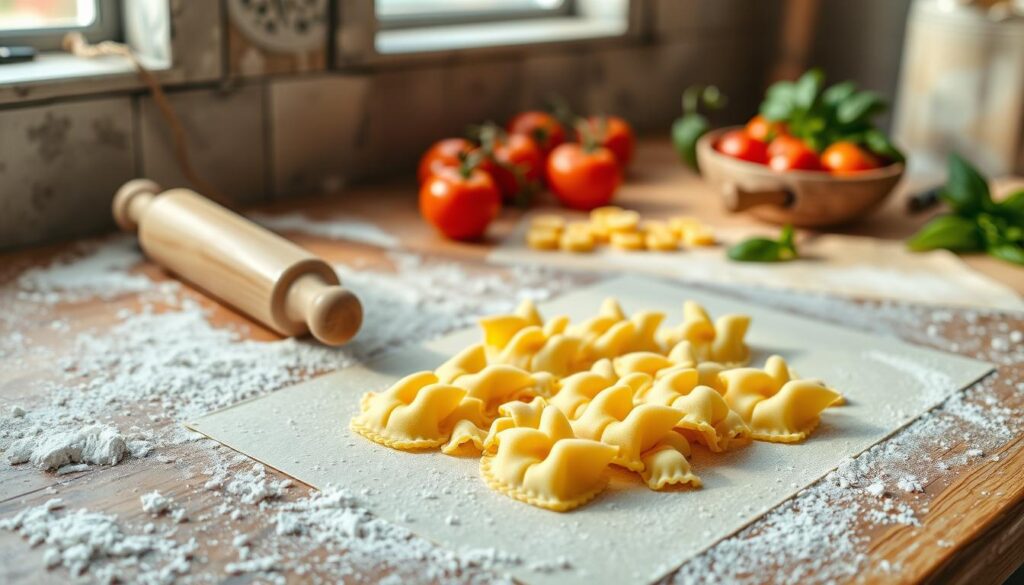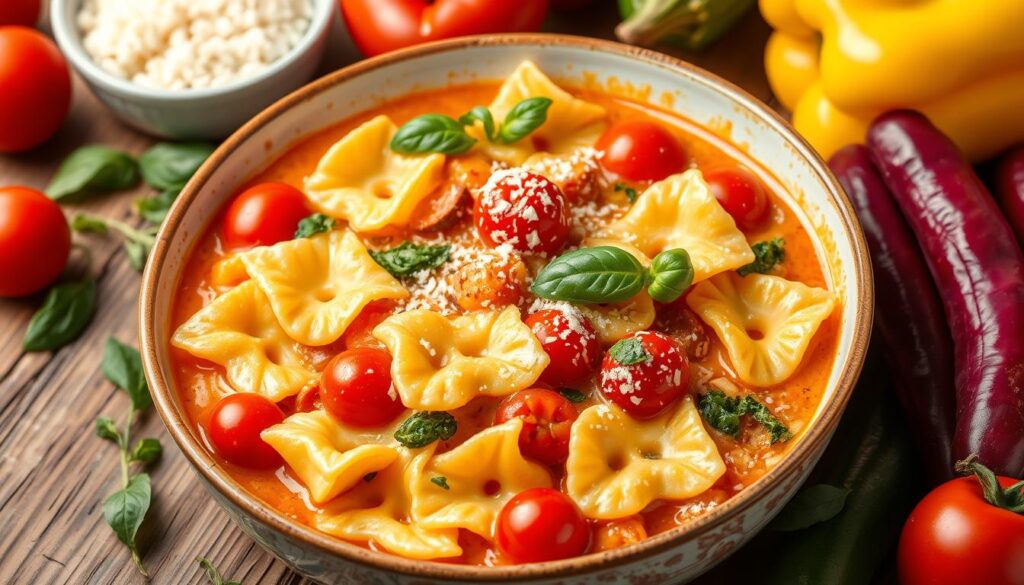Table of Contents
The kitchen is filled with the smell of garlic and tomatoes. It invites you to try the delicate farfalle pasta. This pasta has been loved in Italy for centuries. Once you taste it, you’ll see why it’s so popular everywhere.
Farfalle, or “bow-tie” pasta, started in Northern Italy in the 16th century. It’s now a versatile pasta for numerous meals. From creamy pasta bakes to fresh salads, it’s a delight for your taste senses.
Introduction to Farfalle: The Elegant Butterfly Pasta
Farfalle is a favorite Italian pasta known for its butterfly shape. It comes from the Northern Italian regions of Lombardy and Emilia-Romagna, dating back to the 1600s. This elegant pasta is a key part of Italian cuisine.
Origins and Historical Significance
The name “farfalle” means “butterfly” in Italian. This name fits the pasta’s unique shape perfectly. Its design not only looks great but also holds sauces and ingredients well.
Why Farfalle is a Popular Pasta Choice
Farfalle is loved for its versatility and ability to match many flavors. Its playful shape is a hit with families, especially for children’s meals. It’s also great for tossing in creamy sauces or adding to pasta salads.
Traditional Uses in Italian Cuisine
In Italian cuisine, farfalle pairs well with light, vegetable-based dishes or seafood-centric recipes. Its ability to hold sauces and add visual appeal makes it a beloved staple in Italy.
Understanding Farfalle Pasta’s Unique Shape and Design
Farfalle pasta, also known as “bow-tie” or “butterfly” pasta, has a special shape. This shape makes it stand out from other pasta types. It’s not just pretty; it also helps with how it interacts with sauces and ingredients.
The bow-tie look comes from folding a piece of pasta dough in the middle. This creates the signature shape. The edges are fluted, adding texture and interest. This shape helps sauces stick to the pasta, blending flavors in every bite.
The shape of farfalle pasta is both beautiful and useful. The pinched center and fluted edges trap sauces. This makes it perfect for creamy, tomato-based, or vegetable sauces. The texture also makes the pasta more enjoyable to eat.
Farfalle pasta comes in many colors, like tri-color and black. These colors add to its appeal and versatility. It’s great with simple dressings or in complex pasta bakes. Its unique shape makes every meal special.
Looking for substitutes for farfalle? Gemelli or fusilli are good choices because of their similar texture and shape. But, farfalle’s distinctive bow-tie design is a favorite in Italian cuisine and worldwide.
Essential Ingredients for Making Homemade Farfalle
Making homemade farfalle, the beloved butterfly-shaped pasta, needs a few key ingredients and tools. The base of this classic Italian pasta is high-quality flour. You can choose all-purpose flour or semolina flour.
Flour Selection and Quality
For the best texture, choose all-purpose flour with about 11.5% protein. This protein level helps the homemade pasta dough stay elastic. It keeps the farfalle shape during cooking. Semolina pasta is also a great choice. It’s made from durum wheat and offers the right mix of firmness and softness.
Additional Components and Tools
- Room temperature water to hydrate the dough
- A pinch of salt to enhance the flavor
- A pasta maker (optional, but helpful for consistent shaping)
- A pizza cutter or fluted pastry cutter to shape the farfalle
- A baking tray for air-drying the shaped pasta
Professional Tips for Ingredient Selection
Experienced chefs recommend using the freshest, highest-quality ingredients for making artisanal pasta at home. Make sure the flour’s protein content is right. Also, use water at the right temperature for the best dough. With the right ingredients and patience, you can make delicious homemade farfalle. It will be as good as any semolina pasta from specialty shops.
The Art of Crafting Perfect Farfalle Pasta
Making delicious homemade pasta, like the beautiful farfalle, is a true art. It involves many steps, from making the dough to shaping each piece. Whether you’re new to artisanal pasta or want to improve your pasta making techniques, learning to make farfalle is a great journey.
The first step is to mix and knead the dough right. Use top-quality ingredients like semolina flour and fresh eggs. Knead the dough for 10-15 minutes to make it smooth and elastic.
After preparing the dough, roll it out to the right thickness. This is key to keeping the farfalle’s shape and texture when cooked. Cut the dough into rectangles and pinch the center to form the butterfly shape.
The last step is drying the pasta. Let the farfalle air-dry for 12-24 hours. This helps them keep their shape when cooked, giving you that perfect al dente bite.

Making homemade pasta, especially the delicate farfalle, needs patience and detail. By mastering these pasta making techniques, you can boost your cooking skills. Enjoy the unique flavor and texture of freshly made farfalle pasta.
Cooking Techniques and Best Practices
Mastering the art of cooking pasta to perfection requires attention to detail. The key to achieving the ideal al dente texture lies in the cooking process. Boil the pasta in salted water for 6-10 minutes, depending on the thickness of the noodles. The pasta should be tender yet still firm to the bite, with a delightful chew.
Achieving the Perfect Al Dente Texture
Overcooking pasta can lead to a mushy, undesirable texture. To avoid this common pitfall, keep a close eye on the cooking time and taste the pasta frequently as it nears the recommended doneness. Reserving a small amount of the starchy cooking water can also help you achieve the perfect al dente texture by allowing you to adjust the consistency of the sauce.
Common Cooking Mistakes to Avoid
- Overcooking the pasta, resulting in a mushy texture
- Not using enough water, which can lead to sticking and an uneven cook
- Failing to salt the cooking water, which can result in a bland dish
Professional Kitchen Tips
Seasoned chefs swear by a few key techniques to ensure their pasta dishes are always cooked to perfection. One such trick is to toss the cooked pasta with a small amount of olive oil, which helps prevent sticking. Additionally, reserving a cup of the starchy cooking water can be a game-changer, as it can be used to adjust the consistency of the sauce, helping it cling to the pasta seamlessly.
| Pasta Type | Cooking Time |
|---|---|
| Capellini (Angel Hair) | 3-5 minutes |
| Farfalle (Bow Ties) | 12-15 minutes |
| Shells | 10-18 minutes |
Popular Farfalle Pasta Recipes and Serving Suggestions
Farfalle, the delightful butterfly-shaped pasta, is a staple in Italian cuisine. Its unique shape makes it perfect for many pasta recipes and serving ideas. Dive into the world of farfalle dishes and find new favorites.
The classic Farfalle with Pesto is a favorite. The basil pesto’s nutty flavor pairs well with the farfalle. Another hit is Pasta Freda, a cold pasta salad with farfalle, veggies, and tangy dressing.
For creaminess, try Farfalle with Aurora Sauce. It’s made with tomatoes and cream. Seafood fans will love Farfalle with Salmon and Cream Sauce, a tasty fish and pasta combo.
Farfalle is great in veggie dishes like Vegetable Primavera. It’s also good in Farfalle with Shrimp or Farfalle with Alfredo Sauce for a heartier meal.
No matter if you want a light salad or a creamy dish, farfalle pasta has something for everyone. Explore its endless possibilities and add it to your cooking adventures.
Storage and Preservation Methods
Keeping your homemade dried pasta fresh is key. The right pasta storage can make your homemade pasta preservation last longer. Here’s how to keep your farfalle tasting great and feeling just right.
Proper Drying Techniques
After making your farfalle, let it air-dry for 12 to 24 hours. This step keeps the pasta’s shape and stops it from going bad. Once it’s dry, put it in an airtight container. Store it at room temperature for up to 8 weeks.
Long-term Storage Solutions
- Freeze raw farfalle pasta dough for up to 8 weeks for longer storage.
- Cooked farfalle can stay in the fridge for up to 3 days. Just add a bit of olive oil to stop it from sticking.
Storing your pasta right is important for its quality and taste. By drying and storing it correctly, you can enjoy your homemade pasta for months.
| Storage Method | Shelf Life |
|---|---|
| Dried Farfalle Pasta (Stored at Room Temperature) | Up to 3 Years |
| Cooked Farfalle Pasta (Refrigerated) | Up to 3 Days |
| Frozen Raw Farfalle Pasta Dough | Up to 8 Weeks |
Pairing Farfalle with Different Sauces and Ingredients
Farfalle pasta is special because of its butterfly shape. It’s great for catching flavors, whether they’re light or bold. Let’s look at some tasty ways to enjoy this Italian pasta.
Farfalle pairs well with tomato-based sauces. Its shape fits perfectly with the tangy flavors of marinara or puttanesca sauces. For something creamier, try it with Alfredo or pesto sauce.
Farfalle also works well with oil-based or vegetable-forward sauces. Its delicate shape can handle strong flavors like romesco or balsamic vinaigrette. It’s perfect for Mediterranean pasta salads or light summer dishes.
- Farfalle with creamy pesto and grilled chicken
- Farfalle tossed in a roasted red pepper and artichoke sauce
- Farfalle salad with cherry tomatoes, olives, and a balsamic vinaigrette
Farfalle pasta’s shape and texture make every bite a joy. It’s a great way to explore Italian cuisine and pasta pairings. Let your creativity run wild with this versatile pasta.

Conclusion
Farfalle pasta, with its unique butterfly shape, has become a favorite in Italian cuisine. It’s easy to use in many dishes, from quick weeknight meals to fancy dishes. Whether you make it yourself or buy it, farfalle wins over many cooks and chefs.
Farfalle is a standout among pasta types. It looks great and feels special to eat. It works well with many sauces, like creamy Alfredo or hearty Bolognese. This makes it a favorite in kitchens around the world.
Exploring farfalle pasta can be a fun and rewarding experience. It connects you to Italian traditions and tastes. Try out farfalle and enjoy a tasty journey through Italian cuisine.

